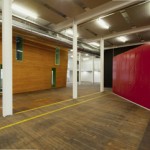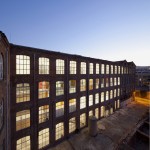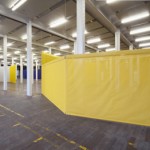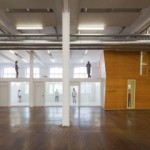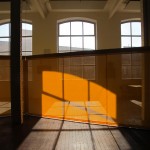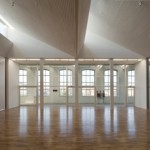Light partions and the insertion of new organs shape the strategu for the recovery of the the Fabra & Coats Factorya as a centre for creative industries.
Intro: a videopresentation screened at Zeppelin Evenings #43 – with Manuel Ruisanchez as a special guest (29 oct. 2012 – Central University Library ”Carol I”, Bucharest)
Serile Zeppelin #43 – Manuel Ruisanchez/ Fabra & Coats, Barcelona from zeppelin on Vimeo.
Text: Manuel Ruisánchez, Francesc Bacardit, Architects
Photo: Ferran Mateo, Shlomi Almagor
Existing situation & program
Built in 1910, the central structure of the Fabra & Coats complex rises up to 4 storeys and consists of three juxtaposed bodies: a large edifice located to the west and two smaller ones oriented to the east and north. Leaning on the east facade of the largest building, a single-storey construction houses the ‘boiler room’, which used to provide energy to the whole compound. The total built area is 14,000 m2.
We aimed the intervention to be highly respectful of the existing building and to achieve a recovery and not just a transformation of an industrial space. Despite the complexity of the functional program – a ‘factory’ of artistic creation, a school of arts and a Heritage Conservation Center comprising a ‘Museum of Labor’ – constructive and structural elements were kept, as well as some of the original systems and facilities.
Strategy and realization
The organization of the access systems and routes on the ground floor allows a clear distribution of the different functional programs and an easy occupation and clearing out of the spaces which host these programs, ensuring the proper functioning of the building’s busiest parts – the common areas of public use.
The upper floors receive creation and training programs. The main building houses the bulk of the activity. The characteristics and dimensions of the other two bodies allow them to become more independent; they are therefore used for the support and management functions of the center and maintain a more direct relationship with the public that accesses the higher plants.
The project strategy is based on the insertion of technological components (the ‘jack’- the new vertical communication shaft, music ‘boxes’ etc…) that can accommodate specific functions and on a flexible space division, through a cable and sails system that allows changes the space according to needs. The structures created by the sails can be installed at different heights, depending on the necessity for privacy and on the type of work to be performed or executed.
Flexibility is also achieved through the variation of thickness and transparency of the separating material.
When a certain hardness is needed in the separation – especially when vertical insulation is indispensable – the rigid elements are converted into recycled wood pannels creating the “music boxes” that are placed, whenever possible, close to the “jack” service core.
The top floor was to house circus, dance and theater activities an therefore needed greater height and a diaphanous type of space. The two rows of pillars were underpinned by a system of Vierendeel type trusses which, in turn, serve as skylights by creating a sawtooth roof.
The only intervention on the original facades was the removal of formerly added elements and the restoration of the surface while keeping the masonry and the woodwork joinery in order to regain the original image of the building.
* This article was published in the 101th issue of Zeppelin magazine (february, 2012)

